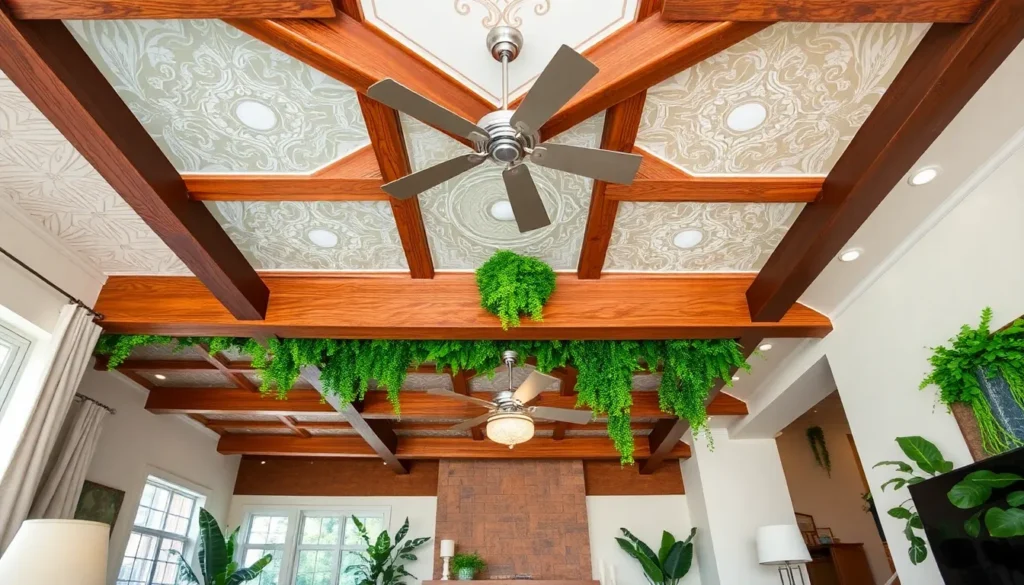When it comes to redefining your living space, the ceiling often gets overlooked. Yet, it holds the potential to transform a room from ordinary to extraordinary. I created this post because I believe a unique ceiling can add character and charm to your living room, making it a focal point that reflects your style. In today’s world, where sustainability is becoming increasingly important, I wanted to offer ideas that not only elevate design but also embrace eco-friendly materials and practices.
If you’re someone who loves home decor or is on a journey to create a sustainable living environment, this guide is for you. Whether you’re redesigning your entire living room or just seeking a fresh update, these living room ceiling ideas will inspire your creativity and enhance your space. From modern ceiling styles to unique treatments that incorporate nature, there’s something here for everyone.
In this post, you’ll discover over 30 ceiling design ideas that cater to various tastes and lifestyles. You’ll find tips on how to utilize reclaimed wood, explore the beauty of painted ceilings, and learn about fascinating treatments like fabric draped ceilings and organic materials. Each idea is designed to spark imagination and help you create a living room that feels personal and inviting. So, let’s dive in and reimagine the ceiling above your head!
Key Takeaways
– Explore over 30 unique living room ceiling ideas that balance style and sustainability.
– Discover eco-friendly materials like reclaimed wood and organic bamboo for a greener home.
– Learn how creative ceiling treatments can enhance natural light and elevate your decor.
– Find inspiration in modern designs like geometric patterns and minimalist white ceilings.
– Get tips for integrating biophilic elements to bring nature indoors for a refreshing atmosphere.
1. Eco-Friendly Reclaimed Wood Beams

Reclaimed wood beams bring a cozy, rustic feel to your living room. You can choose warm tones like rich mahogany or light oak, enhancing the natural beauty of the wood. Pinterest is full of gorgeous examples showing how these beams can stand out against white walls. They add character and a touch of history, making your space feel inviting and unique.
For a budget-friendly option, explore local salvage yards or online marketplaces for reclaimed wood. Mix various wood tones to create depth and interest. This style fits beautifully with farmhouse or modern designs, ensuring your living room feels both stylish and welcoming, perfect for family gatherings or quiet evenings at home.
• Use warm wood tones for a cozy atmosphere.
• Source wood from local salvage yards for savings.
• Mix different woods for added depth in design.
• Pair with neutral walls to let beams shine.
Incorporating reclaimed wood beams will transform your living room into a warm and inviting space filled with character.
Eco-Friendly Reclaimed Wood Beams
Editor’s Choice

BARNWOODUSA Rustic Farmhouse Reclaimed Wood Premium Beam 4x4x24 inch Pos…
 Amazon$29.99
Amazon$29.99
Furniture Clinic Wood Stain | Dark Oak | Water Based | Fast Drying, Low …
 Amazon$11.95
Amazon$11.95
Ekena Millwork 8″W x 8″H Hammered Beam Strap, for use with Heritage Timb…
 Amazon$34.80
Amazon$34.802. Painted Ceilings for a Pop of Color

A painted ceiling can instantly uplift your living room’s vibe, adding a fun and fresh twist. You might go for a soft lavender for a tranquil feel or a bright coral for a lively touch. Many homeowners are opting for this trendy approach, as seen in various interior design blogs. A colorful ceiling can turn a plain room into a stunning focal point.
To keep costs low, consider using leftover paint from other projects. Choose shades that complement your furniture to create harmony in the room. This style works well for those who want to express their unique personality, making your living space feel cheerful and inviting.
• Choose soft pastels for a calming effect.
• Opt for bright colors to energize the space.
• Paint the ceiling matching your decor for harmony.
• Use low-VOC paints for an eco-friendly choice.
A painted ceiling adds personality and warmth, making your living room a joyful retreat.
Fun fact: a painted ceiling can boost a room’s perceived height by up to 20%. Use leftover paint to cut costs while choosing lavender for calm or coral for energy—an easy, practical way to elevate your living room ceiling ideas.
Painted Ceilings for a Pop of Color
Editor’s Choice

Interior Paint and Primer | Non-toxic Water-based Acrylic Latex (Low to …
 Amazon$25.99
Amazon$25.99
Pro Grade Paint Roller Kit, Brush & Roller,10 Piece Set, Wall Painting N…
 Amazon$16.99
Amazon$16.99
4 Rolls Premium Painters Tape, Blue Tape, Masking Tape, Paint Tape for M…
 Amazon$5.99
Amazon$5.993. Skylights for Natural Light
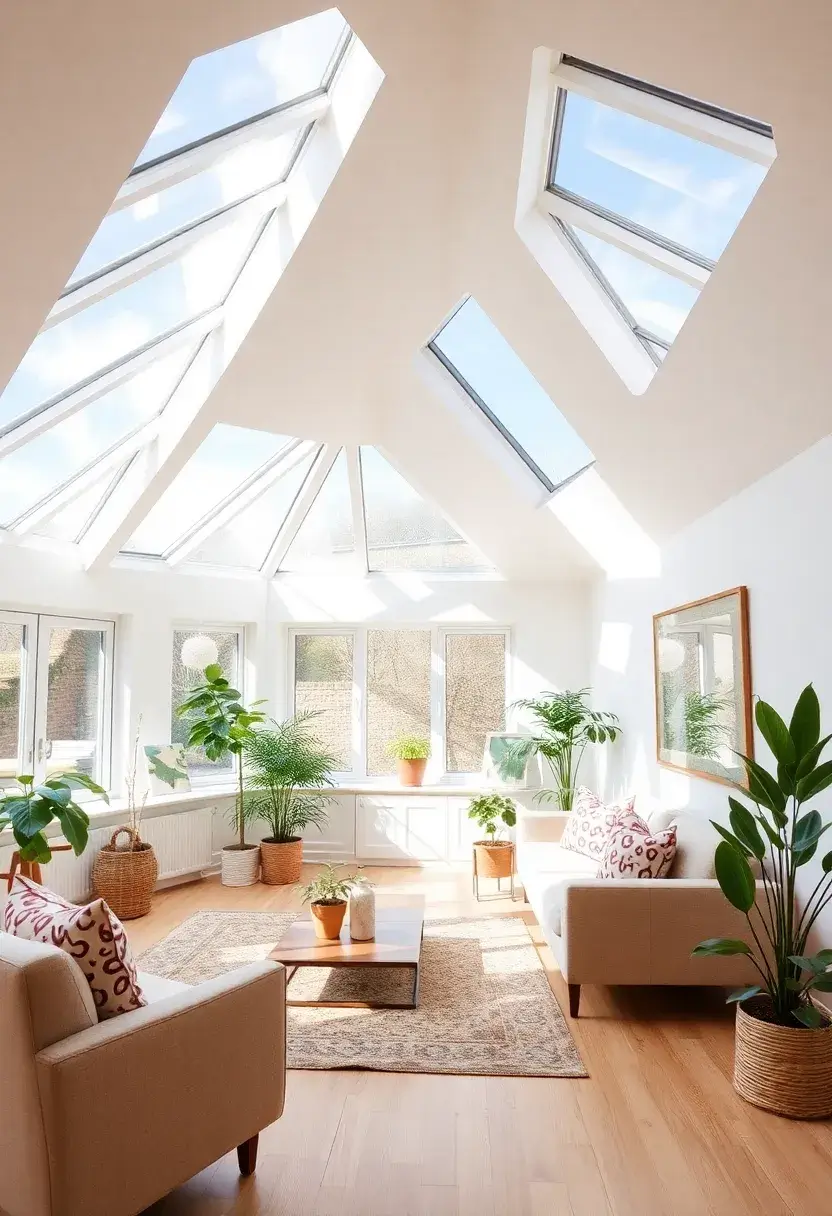
Skylights are an incredible addition to any living room, flooding the space with natural light. You can choose energy-efficient skylights that reduce energy costs while enhancing brightness. This trend is popular in modern homes, creating a bright and airy atmosphere. Skylights not only make the room feel larger but also bring a connection to the outdoors.
When installing skylights, consult a professional to ensure proper placement for maximum light. This approach is budget-friendly if you opt for standard sizes. By letting natural light in, you create a cheerful environment, perfect for relaxing or entertaining.
• Install energy-efficient skylights for savings.
• Choose standard sizes for budget-friendly options.
• Position skylights for optimal light exposure.
• Ensure they open for ventilation if needed.
Skylights will brighten your living room, making it an inviting space filled with light.
Skylights for Natural Light
Editor’s Choice

Skylights & Roof Windows, Custom 19.7-47.2in Roof Skylight Window with G…
 Amazon$312.45
Amazon$312.45
SL1422 RV Skylight Replacement,18″ x 26″ Camper Skylight fits Standard 1…
 Amazon$59.97
Amazon$59.97
Daisypower Dryer Vent Window Kit, Adjustable Window Vent Kit with Outdoo…
 Amazon$33.47
Amazon$33.474. Textured Wall Panels

Textured wall panels on your ceiling can add depth and interest to your living room. Whether you choose bamboo, reclaimed wood, or even foam panels, these options enhance both style and sustainability. This idea is trending in modern designs, creating a unique look that catches the eye. You can play with patterns to reflect your personal taste, making your ceiling a standout feature.
For a budget-friendly option, consider DIY projects using affordable materials. Light colors can keep the room feeling spacious, while accent lighting can highlight the textures beautifully. This approach adds character and modern flair, making your living room feel lively and inviting.
• Choose natural materials for sustainability.
• Use light colors to enhance brightness.
• Consider DIY projects for savings.
• Install accent lighting to highlight textures.
Textured wall panels will transform your living space into a modern, engaging retreat.
Textured Wall Panels
Editor’s Choice

Art3d Natural Bamboo Wall Panel for Interior Wall Decor, Renewable Pole …
 Amazon$68.99
Amazon$68.99
Zeta White (Foam) Ceiling Tile – 40pc Box – Decorative Ceiling Tile Easy…
 Amazon$82.98
Amazon$82.98
Govee RGBIC LED Strip Lights, Smart LED Lights for Bedroom, Bluetooth LE…
 Amazon$13.49
Amazon$13.495. Eco-Conscious Living Moss Ceilings

Living moss ceilings are a unique way to incorporate nature into your home while improving air quality. They absorb sound and humidity, creating a calm environment. This eco-friendly option is perfect for nature lovers, as it connects your space to the outdoors. With the right care, moss can thrive indoors, making your living room feel like a serene oasis.
For a successful installation, ensure the moss is properly maintained and misted regularly. Combine it with natural wood elements for a cohesive look. This idea brings warmth and tranquility, creating a comforting atmosphere in your living space.
• Ensure proper installation for moisture retention.
• Combine with wood elements for harmony.
• Mist regularly to keep the moss vibrant.
• Use moss to create a serene environment.
Living moss ceilings will turn your living room into a tranquil haven where nature thrives.
Eco-Conscious Living Moss Ceilings
Editor’s Choice

ACADOIT Moss ArtsFrame Crafts for Adults, 11″ Home Office Decor Living W…
 Amazon$29.90
Amazon$29.90
2 Pack Continuous Spray Bottles – Ultra Fine Mist Sprayer | Water Spray …
 Amazon$7.63
Amazon$7.63
upsimples Floating Shelves for Wall, Wall Shelves for Decor Storage Set …
 Amazon$23.79
Amazon$23.796. Geometric Patterns in Wood
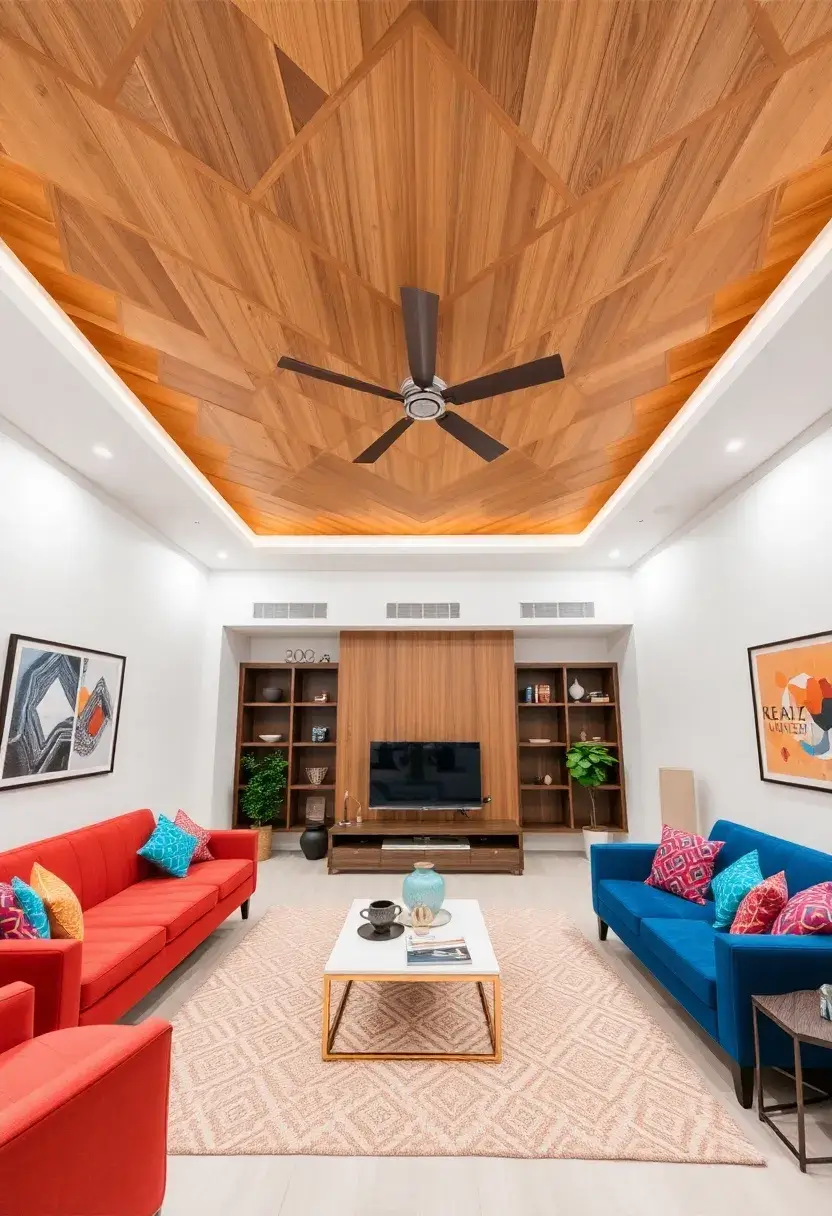
Geometric wooden ceilings introduce a modern touch to your living room. Arrange sustainably sourced wood in fun shapes like triangles or hexagons to create visual excitement. This style works beautifully in contemporary homes, catching the eye of your guests. You can mix wood tones to enhance depth and interest in the design.
For a budget-friendly option, look for reclaimed wood or local sources. Pair these patterns with bold decor colors to keep the energy high. This design choice not only adds flair but also aligns with sustainable living, making your home stylishly eco-conscious.
• Use contrasting wood tones for depth.
• Mix shapes for a playful look.
• Combine with bold decor for energy.
• Ensure wood is sustainably sourced.
Geometric wooden ceilings will impress while keeping your living space trendy and eco-friendly.
Geometric Patterns in Wood
Editor’s Choice

Rockin’ Wood Real Wood Nail Up Application Rustic Reclaimed Naturally We…
 Amazon$459.00
Amazon$459.00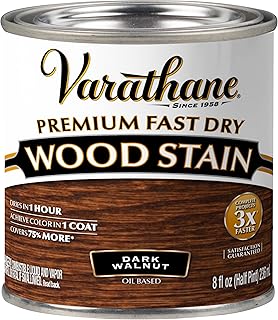
Varathane Premium Fast Dry Wood Stain, Half Pint, Dark Walnut
 Amazon$8.17
Amazon$8.177. Minimalistic White Ceilings
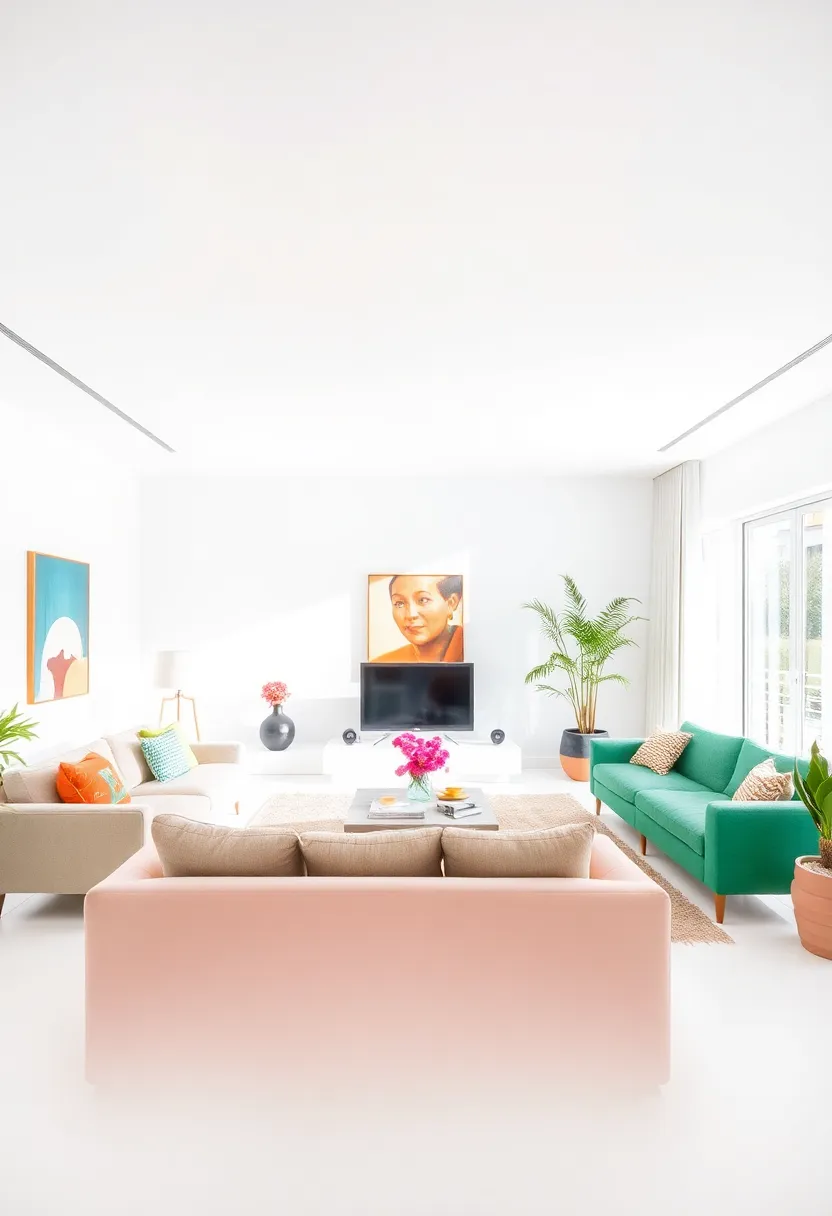
A minimalistic white ceiling is a classic choice that enhances any room’s brightness. It makes spaces feel larger, which is perfect for smaller living areas. You can add subtle textures to keep the look fresh, such as a matte finish or a hint of shine. This timeless design complements various styles and creates a clean, airy atmosphere.
To personalize your space, pair your ceiling with colorful furniture or accents. White-painted beams can add sophistication without overwhelming the design. This approach ensures your living room feels open and inviting, perfect for family gatherings.
• Pair with colorful furnishings for contrast.
• Use white beams for a chic touch.
• Choose recessed lighting for a modern look.
• Keep textures subtle to avoid overwhelm.
A minimalistic white ceiling will create a fresh, bright atmosphere in your living room.
Minimalistic White Ceilings
Editor’s Choice

Amico 12 Pack 6 Inch 5CCT Ultra-Thin LED Recessed Ceiling Light with Jun…
 Amazon$56.68
Amazon$56.68
Zinnser 03688 Covers Up Stain Sealing Ceiling Paint, White
 Amazon$9.76
Amazon$9.76
Ekena Millwork 3 1/2″W x 3 1/2″H x 120″L 3-Sided (U-Beam) Salvaged Timbe…
 Amazon$206.91
Amazon$206.918. Fabric Draped Ceilings

Draping fabric from your ceiling can create a cozy and inviting atmosphere. This style is perfect for those who love bohemian or eclectic decor, adding softness and warmth to the room. Choose sustainable fabrics like organic cotton or linen for an eco-friendly touch. Layering different colors and patterns can add a whimsical feel to your living space.
Make sure the fabric is securely fastened to avoid any safety hazards. You can also add fairy lights for a magical glow in the evenings. This design creates a welcoming and charming environment, making your living room feel like a cozy retreat.
• Use organic fabrics for sustainability.
• Layer colors for a whimsical look.
• Securely fasten fabric to ensure safety.
• Add fairy lights for a magical touch.
Draped fabric ceilings will transform your living room into a warm and inviting haven.
Fabric Draped Ceilings
Editor’s Choice

Cotton Muslin Fabric by Yard – 2 Yards, 60″ Wide, Unbleached, 100% Organ…
 Amazon$19.99
Amazon$19.99
Brightown 12 Pack LED Fairy Lights Battery Operated String Lights – 7ft …
 Amazon$9.99
Amazon$9.99
SLOW DOLPHIN Heavy Duty Spring Clamps Clip 4.5 Inch for Muslin/Paper Pho…
 Amazon$8.49
Amazon$8.499. Concrete Ceiling Treatments
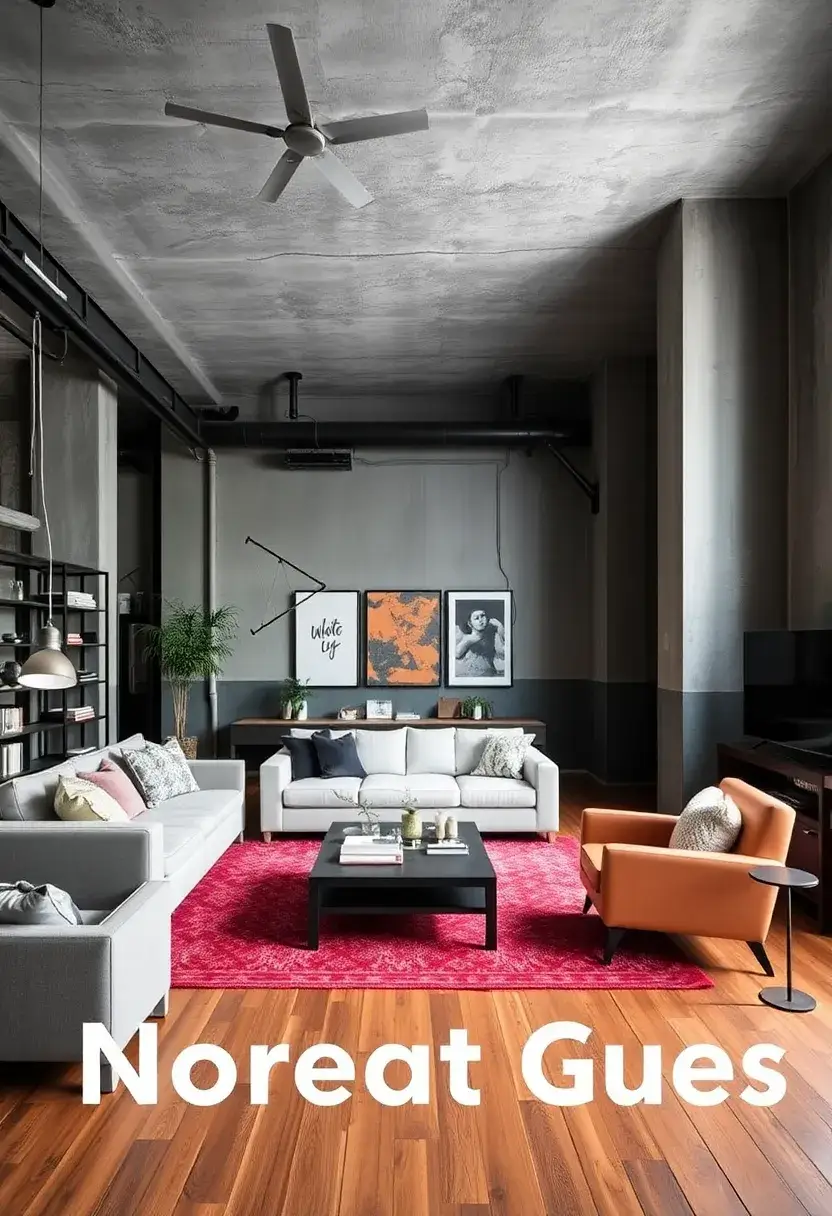
Concrete ceilings add an industrial vibe to modern living rooms. Polished concrete can look sleek and stylish, especially when sourced sustainably. You might consider decorative treatments, like adding color or texture, to soften the hard edges. This design trend can create a unique atmosphere that blends function and style.
For warmth, mix in wooden beams or accents, creating a balance between rough and refined. Minimalistic furniture can complement the rugged look, ensuring the space feels open. This approach appeals to those who appreciate modern design while staying eco-conscious.
• Mix wooden accents for warmth.
• Use minimalistic furniture for balance.
• Incorporate decorative treatments for interest.
• Opt for sustainable concrete for eco-friendliness.
Concrete ceilings will give your living room a striking, modern edge.
Concrete ceilings bring an edgy vibe to living room ceiling ideas—sleek, sustainable, and surprisingly warm when you add wood beams. Keep it balanced with minimal furniture and a splash of color to soften the rugged look.
Concrete Ceiling Treatments
Editor’s Choice
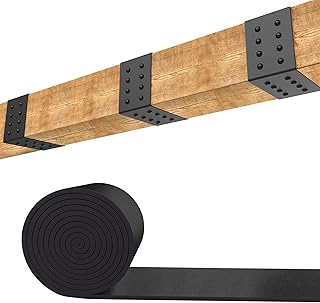
5ft Faux Wood Beam Strap,Flexible Beams Gap Hiding Strap, Wood Beams Met…
 Amazon$13.99
Amazon$13.99
Anbuy Bedroom Sets Begie Sets 2 Pieces, Scalloped 6 Drawer Dresser and N…
 Amazon$299.99
Amazon$299.99
Concrete Stain. in/Outdoor. Industrial-Quality. Eco-Friendly. 19 Colors/…
 Amazon$12.95
Amazon$12.9510. Faux Tin Ceilings

Faux tin ceilings offer a vintage feel without the high price tag. These lightweight panels are easy to install, making them a fun DIY project for eco-conscious homeowners. Look for panels made from recycled materials to keep your design sustainable. Faux tin tiles mimic traditional elegance while remaining budget-friendly.
They come in various finishes and colors, allowing you to match them with your decor easily. Consider using them as an accent rather than covering the entire ceiling for a subtle nod to vintage style. This design adds charm while promoting sustainability in your home.
• Choose lightweight panels for easy installation.
• Opt for recycled materials to stay eco-friendly.
• Use as accents for a vintage touch.
• Match finishes to decor colors for harmony.
Faux tin ceilings will bring character and warmth to your living room while keeping sustainability in mind.
Faux Tin Ceilings
Editor’s Choice

RoomMates TIL4624FLT StickTiles Silver Tin Peel and Stick Tile
 Amazon$13.97
Amazon$13.97
PATCH 100 Count Value Pack, Organic Natural Bamboo Eco-Friendly Adhesive…
 Amazon$22.99
Amazon$22.99
RoomMates TIL4624FLT StickTiles Silver Tin Peel and Stick Tile
 Amazon$13.97
Amazon$13.9711. Organic Bamboo Ceilings
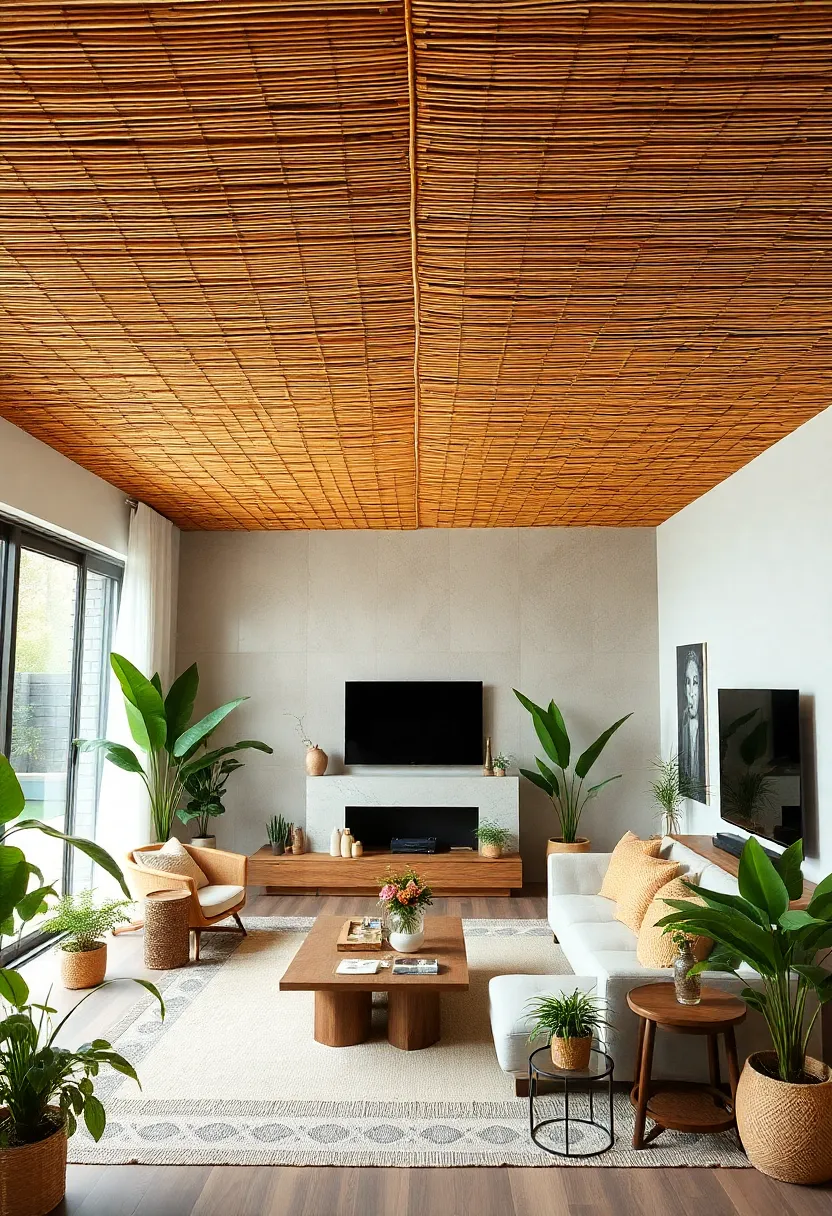
Organic bamboo ceilings are a sustainable choice that brings natural beauty into your living space. Bamboo is lightweight yet strong, making it a great option for various ceiling designs. You can install bamboo in slats or panels, providing a unique look that pairs well with natural decor. This idea promotes an eco-friendly lifestyle while adding a touch of the exotic.
Consider using bamboo alongside houseplants for a lush indoor environment. This design choice offers sound insulation while maintaining an open feel, creating a serene atmosphere. Your living room will feel fresh and inviting, perfect for relaxing or entertaining guests.
• Install bamboo slats for a unique look.
• Pair with houseplants for a lush feel.
• Enjoy sound insulation benefits.
• Choose organic bamboo for sustainability.
Organic bamboo ceilings will elevate your living room, making it a peaceful retreat.
Organic Bamboo Ceilings
Editor’s Choice

Art3d Natural Bamboo Wall Panel for Interior Wall Decor, Renewable Pole …
 Amazon$79.99
Amazon$79.99
Costa Farms Live Plants (3 Pack), Easy to Grow Real Indoor Houseplants, …
 Amazon$31.13
Amazon$31.13
Focusound 52 Pack Acoustic Foam Panels 1″ x 12″ x 12″ Sound Proof Foam P…
 Amazon$36.99
Amazon$36.9912. Vintage Wood Paneling
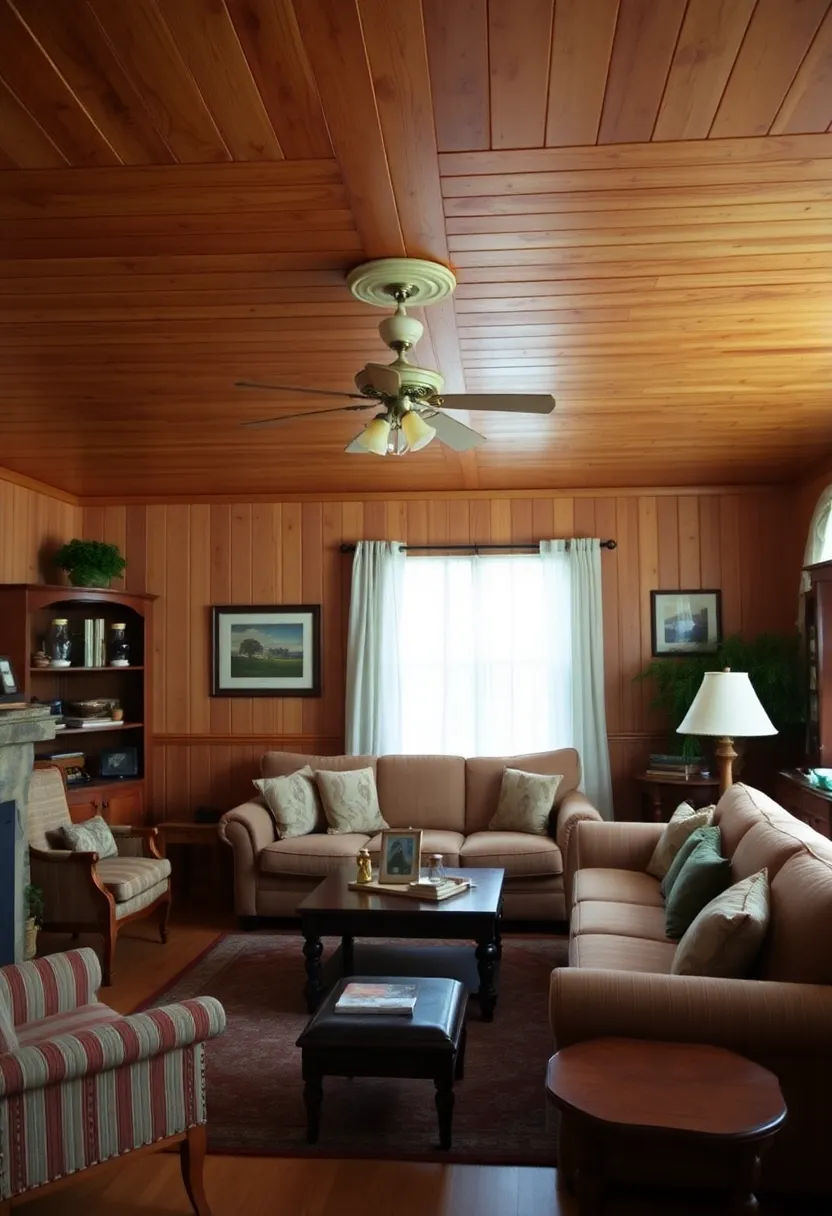
Vintage wood paneling brings classic charm to your living room while promoting sustainability. You can choose reclaimed wood for an eco-friendly option that adds character and warmth. This design works beautifully in traditional and rustic homes, creating a cozy, inviting atmosphere. With the right finish, you can showcase the wood’s natural beauty for a timeless look.
Consider pairing vintage paneling with modern furnishings for a striking contrast. Warm lighting enhances the cozy feel and draws attention to the wood’s rich textures. This style is perfect for anyone looking to add history and charm to their living space.
• Use reclaimed wood for sustainability.
• Combine with modern furnishings for contrast.
• Add warm lighting to enhance the atmosphere.
• Choose a clear finish to showcase natural beauty.
Vintage wood paneling will create a warm and inviting living room filled with charm.
Vintage Wood Paneling
Editor’s Choice

Peel & Stick Real Wood Planks, Rustic Reclaimed Barn Wood Paneling, Brow…
 Amazon$59.99
Amazon$59.99
Floor Lamp, Adjustable Height Floor Lamps for Living Room Bedroom, 120 L…
 Amazon$28.48
Amazon$28.48
Minwax 233334444 Polycrylic Protective Wood Finish, Clear Satin, ½ Pint
 Amazon$11.48
Amazon$11.4813. Artistic Ceiling Murals
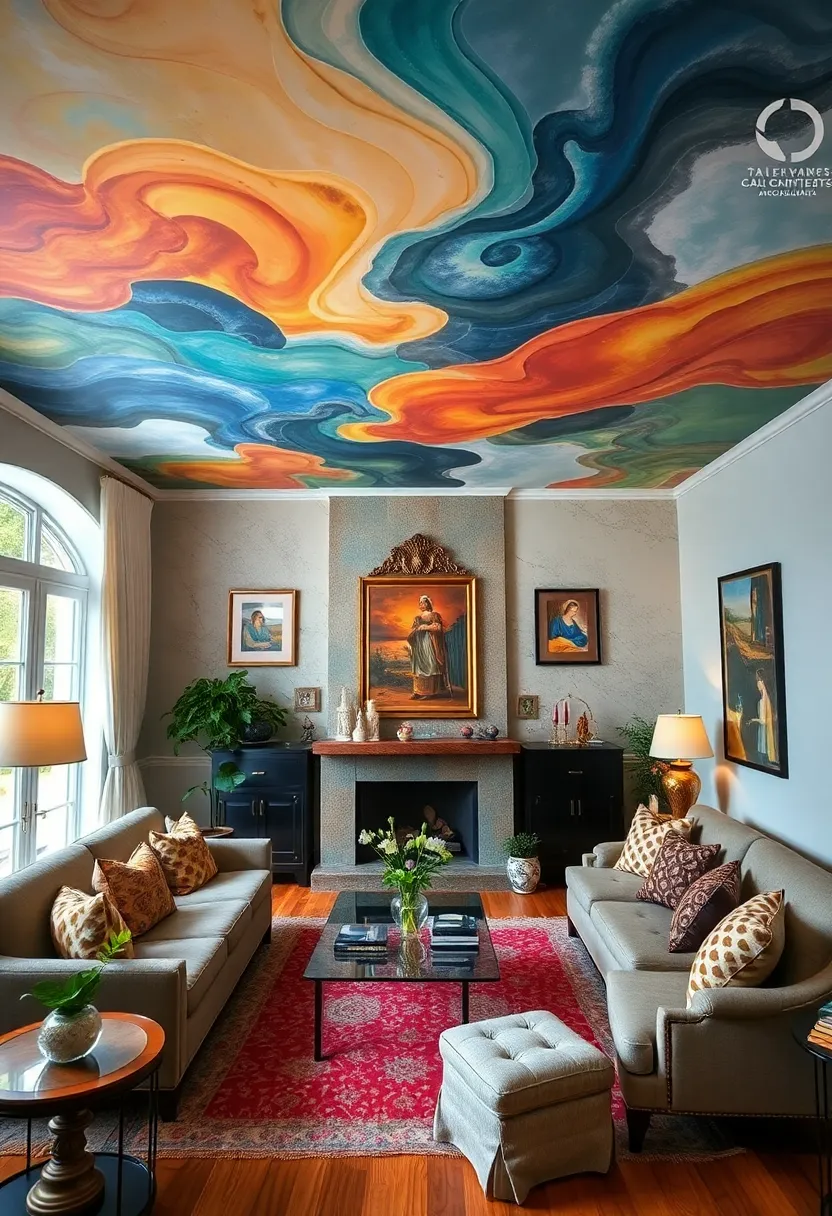
Artistic murals on the ceiling can transform your living room into a true masterpiece. You might consider hand-painted designs or wallpaper murals to express your creativity. This idea allows for personalization, making your space feel unique and inviting. Bright floral patterns or abstract art can add vibrancy and charm to your ceiling.
When choosing designs, make sure they harmonize with the overall decor. Use environmentally friendly paints to keep things sustainable. Artistic murals not only beautify your space but also serve as delightful conversation starters, making your living room truly one-of-a-kind.
• Choose hand-painted designs for uniqueness.
• Opt for floral patterns for vibrancy.
• Use environmentally friendly paints for sustainability.
• Ensure designs harmonize with decor.
Artistic ceiling murals will turn your living room into a vibrant and creative haven.
Artistic Ceiling Murals
Editor’s Choice

White Paint, 500g Wall Paint, Integrated Paint Roller for Flat, Ceiling …
 Amazon$14.99
Amazon$14.99
FWIEXA Black Peony Floral Wallpaper, Dark Purple Flower Wall Mural, Gree…
 Amazon$114.99
Amazon$114.99
FINGERINSPIRE 6 Pcs Hand Pattern Stencils 11.7×8.3 Inch Sun Moon Star Pl…
 Amazon$8.29
Amazon$8.2914. Cross-Laminated Timber
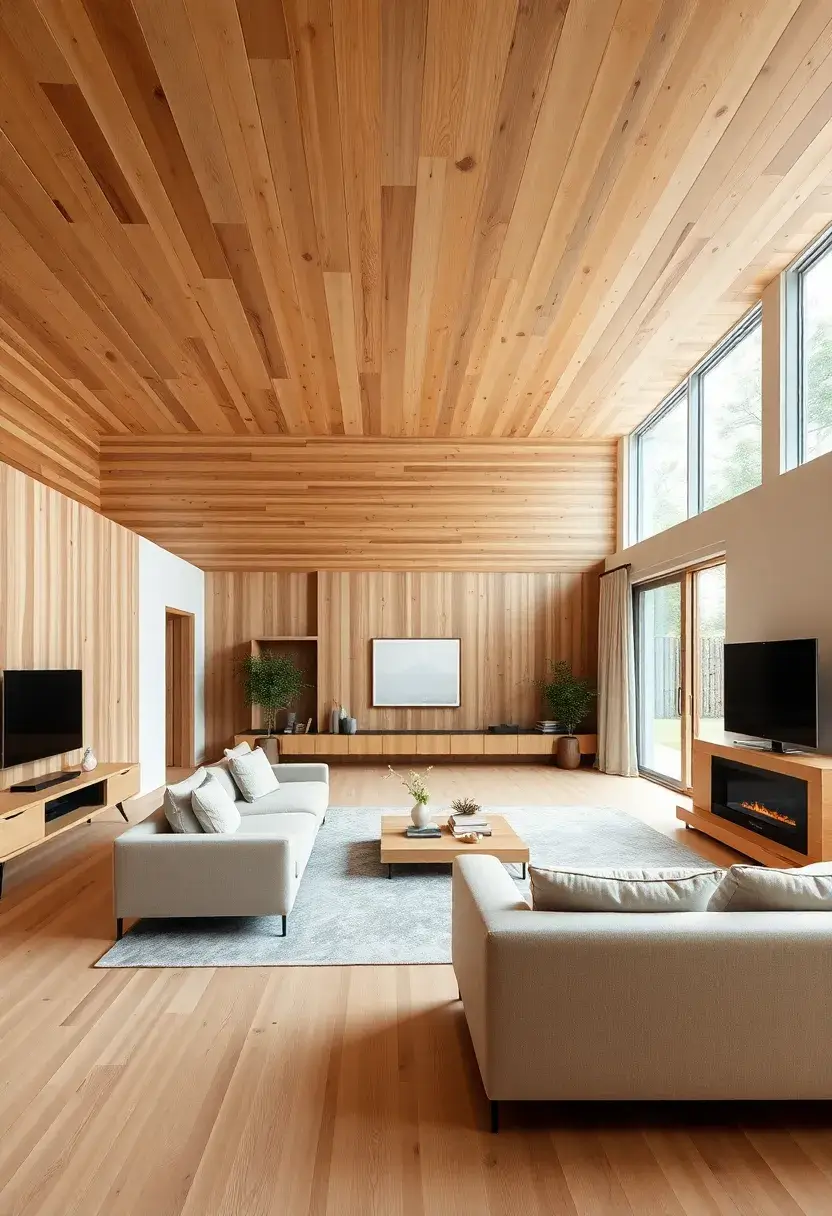
Cross-laminated timber (CLT) is becoming popular for its strength and sustainability. Using CLT panels for your ceiling creates a unique look while reducing carbon emissions. This material gives your space a modern aesthetic while ensuring structural stability. You can design CLT ceilings in various shapes, adding depth and interest to your living room.
For the best results, pair CLT with other natural materials like wood or stone. This approach enhances the eco-friendly aspect of your design while creating a chic and contemporary feel. Your living room will feel stylish and environmentally conscious, perfect for entertaining or relaxing.
• Use CLT panels for strength and sustainability.
• Combine with natural materials for harmony.
• Design in various shapes for interest.
• Ensure structural stability for safety.
Cross-laminated timber ceilings will elevate your living space with a modern and eco-friendly touch.
Cross-Laminated Timber
Editor’s Choice
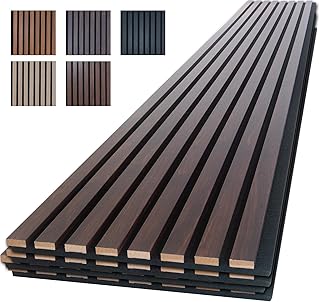
NeatiEase Wood Panels for Wall, 4-Piece 96″ x 12.6″ Soundproof Wood Slat…
 Amazon$169.99
Amazon$169.99
Furniture Clinic Wood Stain | Dark Oak | Water Based | Fast Drying, Low …
 Amazon$11.95
Amazon$11.95
Ancient Graffiti Medium 5-Stone Natural River Stone Cairn, Multicolor, 8in
 Amazon$34.99
Amazon$34.9915. Decorative Ceiling Tiles
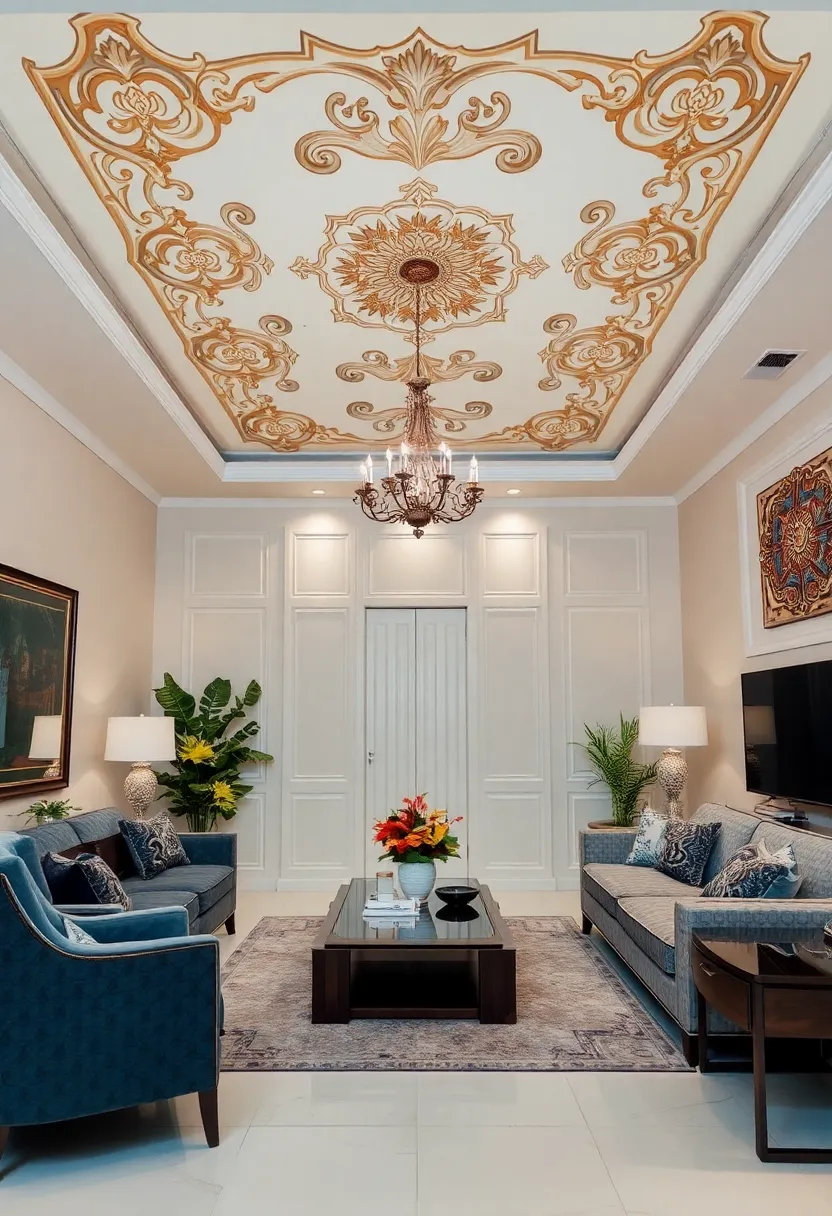
Decorative ceiling tiles can add flair and character to your living room without overwhelming the space. You can opt for eco-friendly materials to maintain a sustainable design. These tiles come in various styles, from traditional to modern, allowing you to express your personality. Using them as accents can create a striking feature area, perfect for larger rooms.
Mixing different patterns can bring a vibrant look to your ceiling. Pair the tiles with simple furnishings to avoid a cluttered feel. This design choice adds charm while supporting eco-friendly principles, making your living room stylish and sustainable.
• Choose eco-friendly materials for sustainability.
• Use tiles to create feature areas in larger rooms.
• Mix patterns for a vibrant look.
• Pair with simple furnishings to keep it balanced.
Decorative ceiling tiles will infuse your living room with character and style while staying eco-conscious.
Decorative Ceiling Tiles
Editor’s Choice
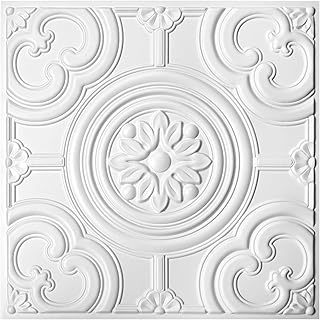
WOWSTAR 12-Pack 24″x24″ Drop Ceiling Tiles, Waterproof Glue up Ceiling P…
 Amazon$59.99
Amazon$59.99
À LA MAISON CEILINGS Instant Grab Adhesive – High-Strength Glue for Ceil…
 Amazon$45.00
Amazon$45.00
Antetek Set of 3 Teddy Sofa for Living Room, Modern 2 Units Deep Seat So…
 Amazon$649.99
Amazon$649.9916. Vintage Tin Ceiling Tiles
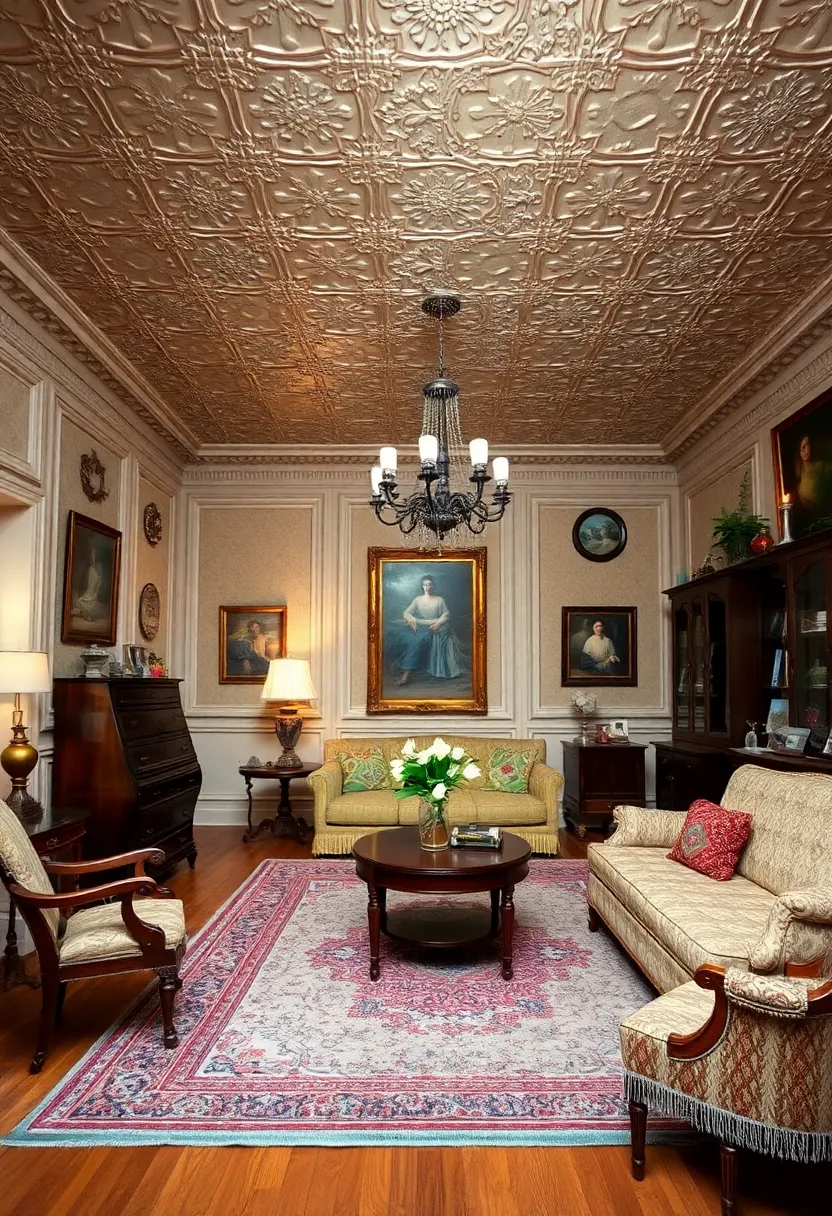
Vintage tin ceiling tiles bring nostalgia and charm to modern living spaces. You can often find these tiles at thrift stores or online, making them an eco-friendly choice that supports upcycling. Their timeless aesthetic blends classic and contemporary styles, enhancing the character of your room. You might even paint them in trendy colors to match your decor for a unique twist.
Consider using them as accents instead of covering the entire ceiling for a subtle touch. Proper installation is essential to prevent rusting and maintain their beauty. This design element adds a unique flair while promoting sustainable practices in your home.
• Look for thrifted tiles to save money.
• Paint in trendy colors for modern appeal.
• Use as accents rather than full coverage.
• Ensure proper installation to avoid rust.
Vintage tin tiles will add charm and character to your living room with a nod to sustainability.
Vintage Tin Ceiling Tiles
Editor’s Choice
![30+ Inspiring Living Room Ceiling Ideas for Every Design Style 105 American Tin Ceilings [5 Pack Kit] 24](https://m.media-amazon.com/images/I/71u5SM482JL._AC_UL320_.jpg)
American Tin Ceilings [5 Pack Kit] 24″ x 24″ 100% Tin Nail-Up Ceiling Ti…
 Amazon$50.00
Amazon$50.00
Rust-Oleum 7798830 Stops Rust Spray Paint, 12 oz, Semi-Gloss Black
 Amazon$6.47
Amazon$6.47
À LA MAISON CEILINGS Instant Grab Adhesive – High-Strength Glue for Ceil…
 Amazon$45.00
Amazon$45.0017. Barrel Vault Ceilings

Barrel vault ceilings add elegance and height to your living room. This architectural feature creates a stunning open environment filled with character. Consider using eco-friendly materials for the construction to keep it sustainable. Natural light can enhance the visual appeal of the curves, making your space feel bright and airy.
Pair barrel vault ceilings with light-colored furnishings to maintain a spacious feel. Indirect lighting along the curves can add drama and accentuate the design. This style is perfect for those seeking a refined look in their living room.
• Use eco-friendly materials for construction.
• Incorporate natural light for brightness.
• Choose light colors for furnishings to enhance spaciousness.
• Add indirect lighting for drama.
Barrel vault ceilings will elevate your living room with sophistication and elegance.
Barrel Vault Ceilings
Editor’s Choice

Art3d Drop Ceiling Tiles, 24x48in. White (12-Pack), Polyvinyl Chloride (…
 Amazon$109.99
Amazon$109.99
Loveseat Sofa Couch for Living Room with USB Type C Ports – Light Gray U…
 Amazon$199.99
Amazon$199.99
Amico Recessed Lighting 5/6 Inch, 12 Pack 5CCT Flat LED Can Lights, 2700…
 Amazon$49.99
Amazon$49.9918. Plywood Panel Ceilings
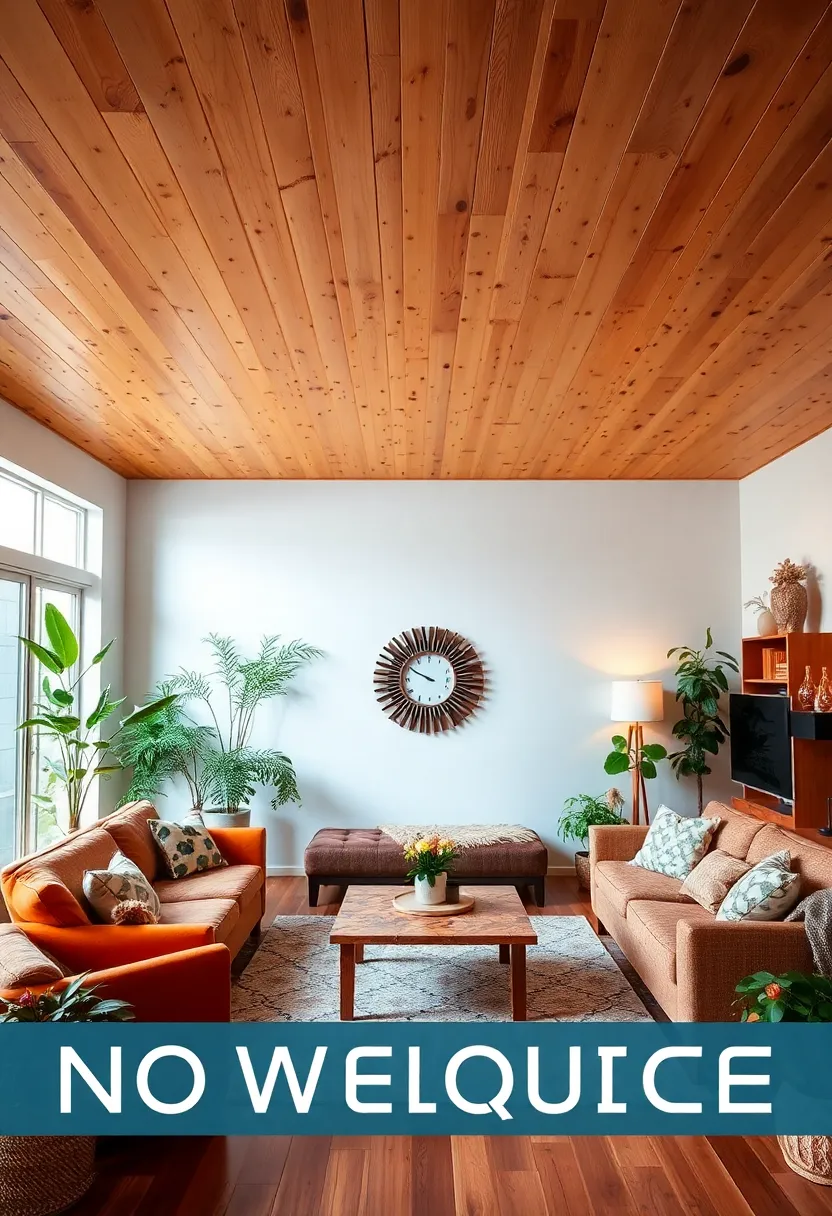
Plywood panels offer a budget-friendly and sustainable option for your living room ceiling. This material can create a warm, rustic atmosphere that fits various design styles. You might choose birch or marine-grade plywood for durability and a polished look. This approach allows you to achieve a cozy aesthetic while promoting eco-consciousness.
Stain or paint the plywood to match your decor for a personal touch. Using different panel widths can add texture and visual interest to the ceiling. Pairing with hanging plants enhances the natural vibe, making your living room feel fresh and inviting.
• Choose birch or marine-grade plywood for durability.
• Stain or paint panels to match your decor.
• Use different widths for added texture.
• Pair with hanging plants for a natural feel.
Plywood panel ceilings will create a cozy and inviting atmosphere in your living room.
Plywood Panel Ceilings
Editor’s Choice

10Pcs 16 x 12 x 1/8 Inch Baltic Birch Plywood Sheets 3mm Unfinished Plyw…
 Amazon$23.99
Amazon$23.99
Furniture Clinic Wood Stain | Teak | Water Based | Fast Drying, Low Odor…
 Amazon$11.95
Amazon$11.95
Set of 2-10 Inch Hanging Planters for Indoor Plants with Self-Watering I…
 Amazon$24.99
Amazon$24.9919. Biophilic Design Elements
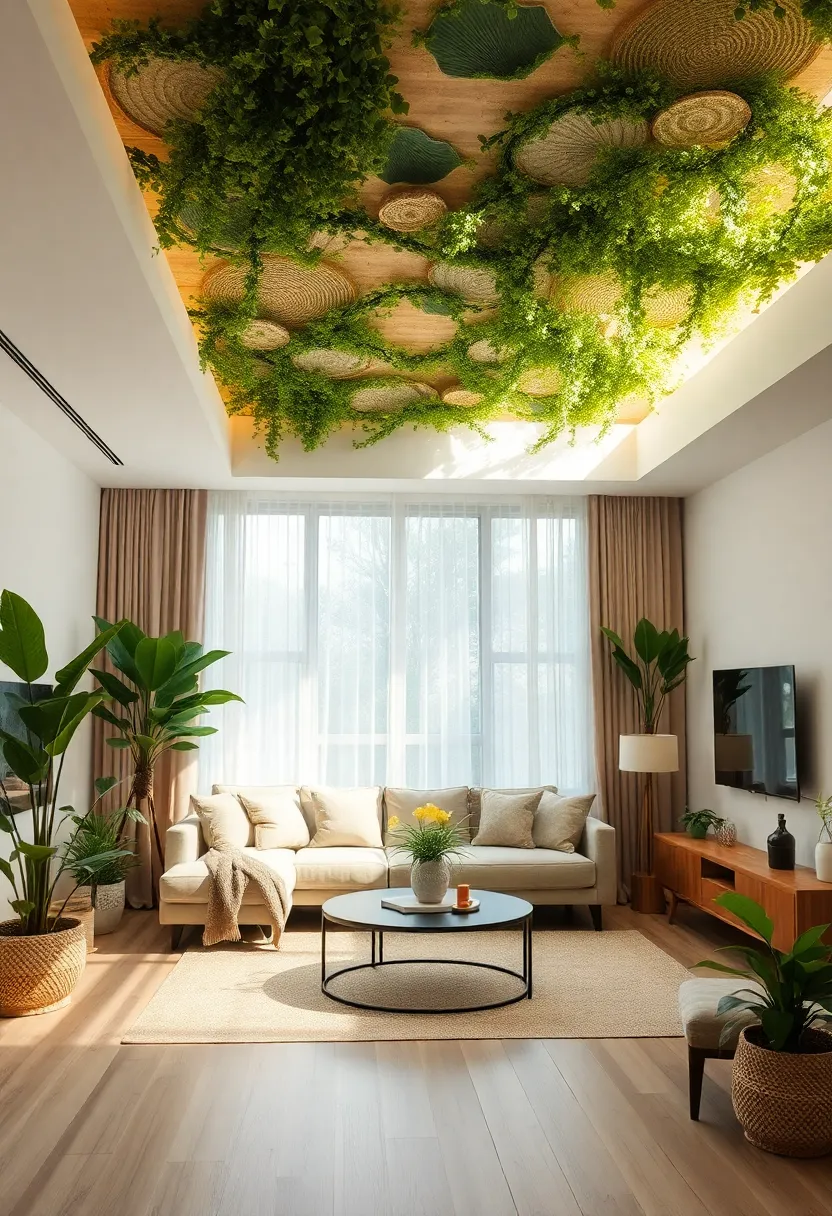
Integrating biophilic design into your ceiling brings nature indoors, enhancing your living space. This can include using natural materials like wood or stone, or even incorporating living plants. The goal is to create a direct connection with nature, promoting well-being and tranquility. This approach is increasingly popular, making your home feel fresh and inviting.
Consider using wooden beams or panels in various styles to express your personality. Hanging plants can add greenery, while ensuring natural light flows into the room helps to brighten the space. This design choice not only looks beautiful but also supports health and wellness, making your living room a peaceful retreat.
• Use natural materials for a calming effect.
• Incorporate hanging plants for greenery.
• Ensure natural light flows for brightness.
• Choose wooden elements for warmth.
Biophilic design elements will create a serene and inviting living room that connects you with nature.
Biophilic Design Elements
Editor’s Choice
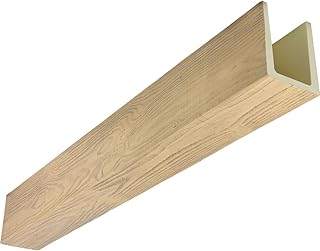
Ekena Millwork 3 1/2″W x 5 1/2″H x 144″L 3-Sided (U-Beam) MENA HeritageT…
 Amazon$282.50
Amazon$282.50
Set of 2-10 Inch Hanging Planters for Indoor Plants with Self-Watering I…
 Amazon$24.99
Amazon$24.99
MIULEE Natural White Linen Curtains 84 Inch Long for Bedroom Living Room…
 Amazon$18.95
Amazon$18.9520. Radiant Heating Panels
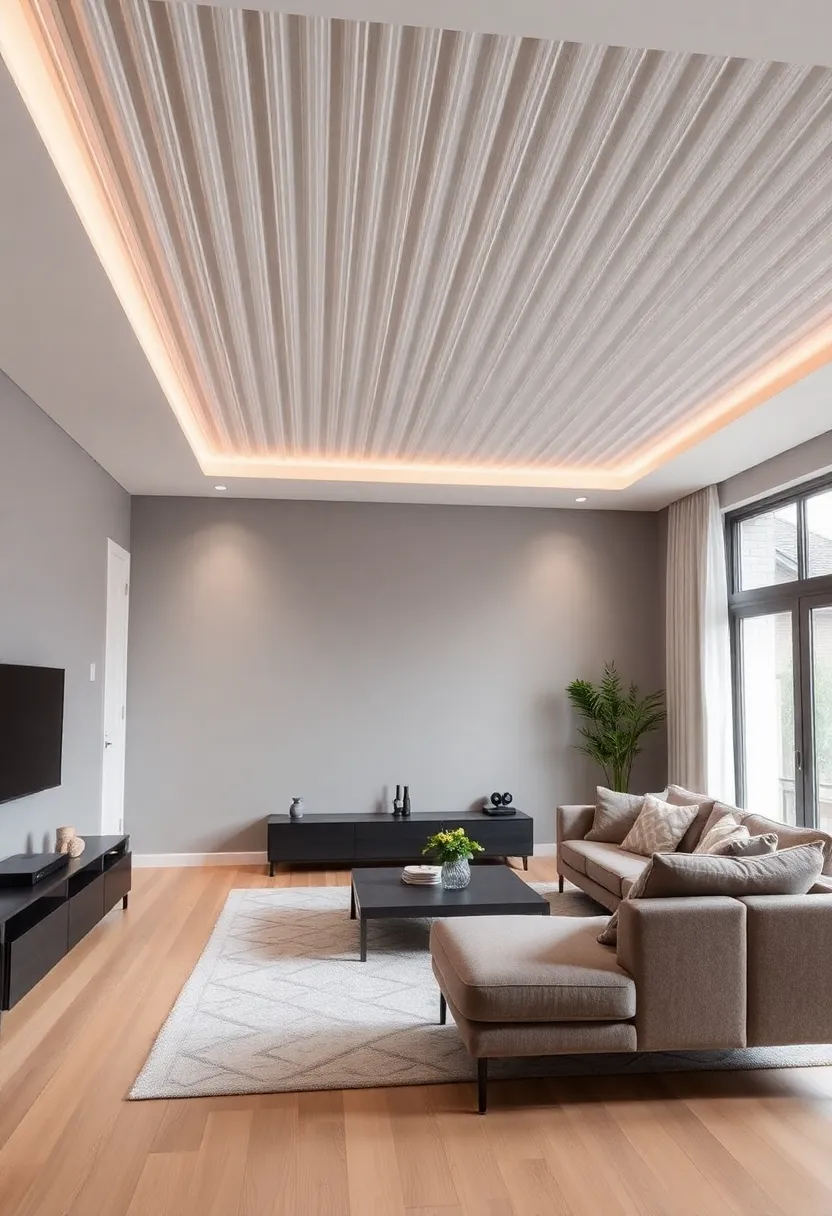
Radiant heating panels offer a stylish and functional solution for your living room ceiling. These panels provide warmth without bulky heaters taking up space, making them practical and efficient. You can integrate them seamlessly into the design, keeping your space clean and modern. This innovative option keeps your living area cozy while maintaining aesthetic appeal.
Choose panels that fit your ceiling style for a coordinated look. High ceilings can enhance efficiency, so consider this when planning your design. Opt for energy-efficient models to keep your environmental impact low, ensuring your home stays comfortable without sacrificing style.
• Choose panels that fit your ceiling style.
• Use in high ceilings for efficiency.
• Opt for energy-efficient models to save energy.
• Keep the design clean and modern.
Radiant heating panels will elevate your living room’s comfort while maintaining a chic look.
Fun fact: Radiant heating panels fit right into living room ceiling ideas, keeping heat near you without bulky radiators. They can cut energy use by up to 25-30% with high ceilings, delivering cozy warmth and a clean, modern look.
Radiant Heating Panels
Editor’s Choice


2 Pack Universal Light Fixture Mounting Bracket, 4 Inches Diameter Steel…
 Amazon$6.29
Amazon$6.2921. Acoustic Panels for Sound Control

Acoustic panels are a great solution for soundproofing while adding style to your ceiling. These panels come in various colors and designs, allowing you to personalize your living space. Sourced from sustainable materials, they help maintain an eco-friendly atmosphere while enhancing acoustics. This approach is perfect for those who want both beauty and function in their home.
Consider geometric designs for a modern look that captures attention. Pair the colors with complementary decor for a harmonious feel. Install the panels in strategic locations for maximum sound absorption, ensuring your living room sounds as good as it looks.
• Choose geometric designs for a modern touch.
• Pair colors with complementary decor for harmony.
• Install in strategic locations for effectiveness.
• Source from sustainable materials for eco-friendliness.
Acoustic panels will enhance both the look and sound quality of your living room.
Acoustic Panels for Sound Control
Editor’s Choice

Focusound 52 Pack Acoustic Foam Panels 1″ x 12″ x 12″ Sound Proof Foam P…
 Amazon$36.99
Amazon$36.99
Zzbakress 4 Pcs Large Black Wall Decor Abstract Metal Wall Art Minimalis…
 Amazon$18.99
Amazon$18.9922. Faux Finish Ceilings
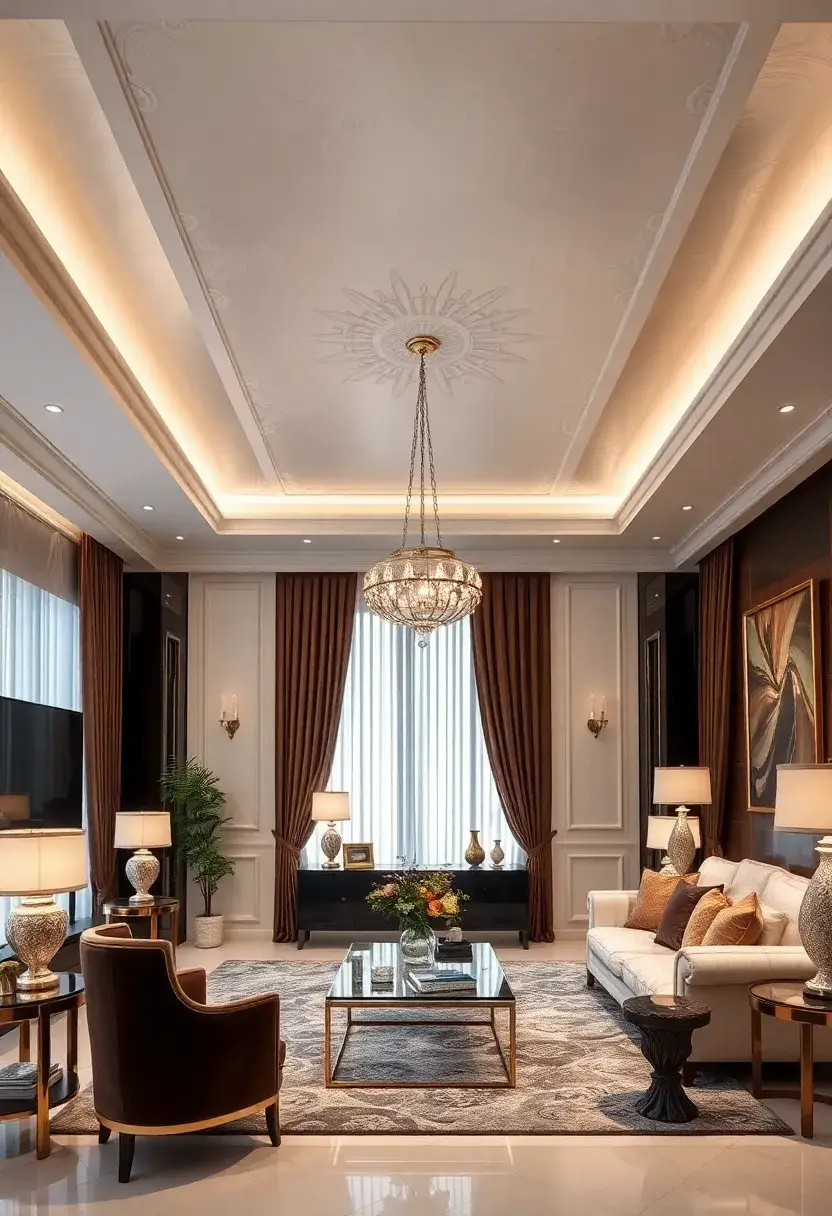
Faux finish ceilings offer an affordable way to achieve high-end looks. Techniques like sponge painting or metallic finishes can elevate your living room’s design without breaking the bank. Choosing sustainable paints will help keep your project eco-friendly while adding personality to your space. This approach allows for creativity and innovation in your ceiling design.
Pick techniques that align with your overall decor style for a seamless look. Selecting colors that complement your furnishings will ensure harmony throughout the room. Using stencils can add artistry without requiring much effort, letting you express your creativity easily.
• Choose techniques that align with your decor.
• Select colors that complement furnishings.
• Use stencils for easy artistry.
• Prioritize sustainable paints for eco-friendliness.
Faux finish ceilings will allow you to express your creativity while maintaining a stylish and sustainable living space.
Faux Finish Ceilings
Editor’s Choice

Shuttle Art Outdoor Acrylic Paint Set, 12 Colors Waterproof Paint, 8.45o…
 Amazon$35.99
Amazon$35.99
Zonon 4 Pieces Reusable Tile Stencil Floor 12 x 12 Inches Wall Templates…
 Amazon$7.99
Amazon$7.99
Natural Sea & Synthetic Sponges – Assorted Sizes 7pc Value Pack for Craf…
 Amazon$13.99
Amazon$13.9923. Sustainable Fabric Ceilings
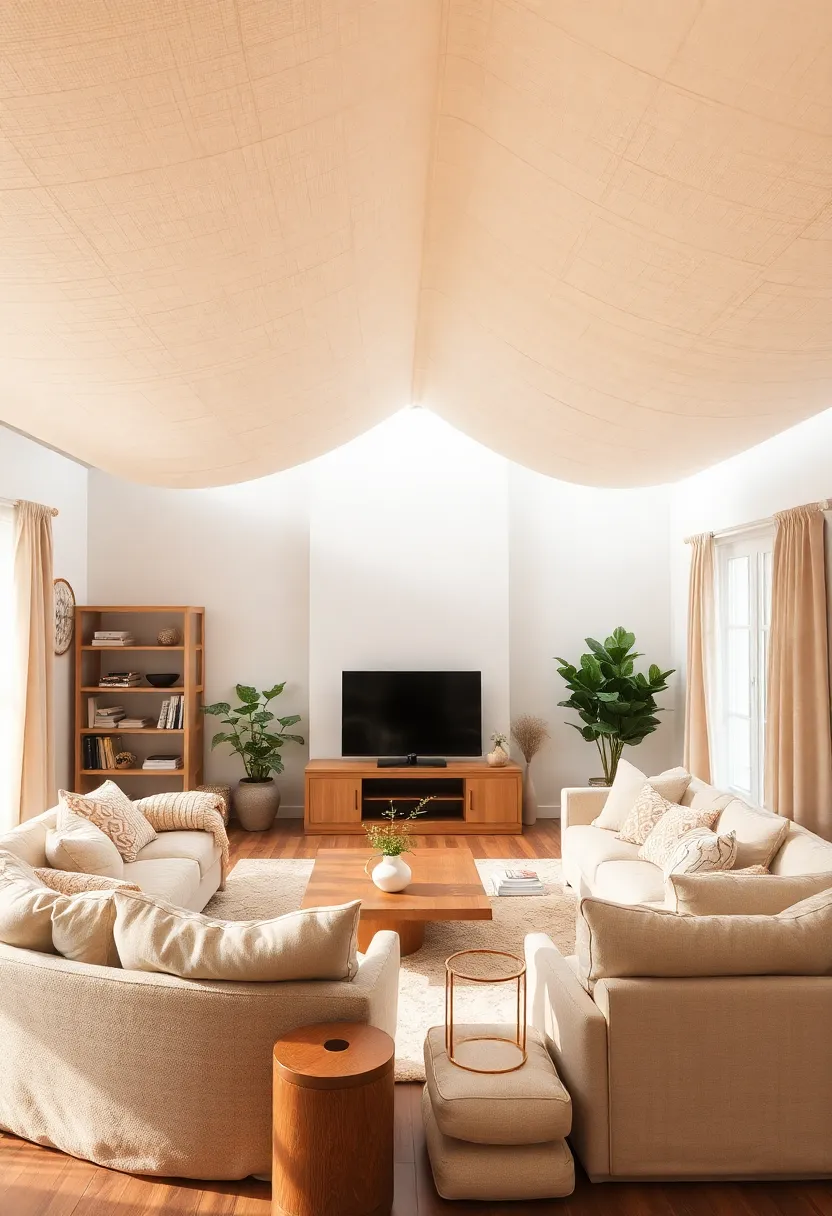
Sustainable fabric ceilings create a soft, inviting atmosphere in your living room. Using organic or recycled fabrics not only supports sustainability but also adds a unique touch. Draping techniques can create a relaxed feel, enhancing the overall ambiance of the room. This approach is perfect for those who want a cozy, inviting space.
Layering different fabrics can create depth and visual interest, while ensuring colors match your decor palette adds harmony. Make sure the fabrics are securely fastened for safety. This design choice promotes comfort, making your living room feel like a cozy haven.
• Layer different fabrics for depth.
• Ensure colors match your decor palette.
• Securely fasten fabrics for safety.
• Choose organic or recycled fabrics for sustainability.
Sustainable fabric ceilings will create a warm and inviting living room that feels like a cozy retreat.
Sustainable Fabric Ceilings
Editor’s Choice

1 Yard Organic Cotton Flannel Cloth for Castor Oil Pack Wrap.Unbleached …
 Amazon$9.99
Amazon$9.99
SOWAKA 30 Pcs Twist Pins Upholstery Clear Heads Slip Cover Fasteners Hea…
 Amazon$4.99
Amazon$4.99
50 Pieces Multi-Colors Fabric Patchwork Mixed Squares Bundle Sewing Quil…
 Amazon$9.99
Amazon$9.9924. Wood and Plaster Combinations

Combining wood and plaster on the ceiling creates a beautiful contrast while promoting sustainability. Wood adds warmth, while plaster can provide a smooth finish and unique textures. This combination works well in both traditional and modern settings, allowing for creativity in design. You can use plaster for intricate designs or moldings, enhancing the character of your living space.
Using reclaimed wood ensures an eco-friendly touch while adding visual interest. Incorporating lighting features can highlight the textures and enhance the overall design. This approach allows your living room to feel stylish and inviting while staying true to sustainable practices.
• Use plaster for intricate designs.
• Choose reclaimed wood for sustainability.
• Incorporate lighting features to enhance textures.
• Create a balance between warmth and elegance.
Wood and plaster combinations will create a beautiful and inviting living space that reflects your style.
Wood and Plaster Combinations
Editor’s Choice

À LA MAISON CEILINGS WP01nm-96 Foam Wood Ceiling Planks 39 in x 6 in, Na…
 Amazon$279.92
Amazon$279.92
Ekena Millwork PML08X08AS Ashford Corner (matches moulding PML01X00AS) P…
 Amazon$7.26
Amazon$7.26
4 Pack LED Flush Mount Ceiling Light, 24W Ultra Thin Round White 3000k/4…
 Amazon$34.99
Amazon$34.9925. Recycled Materials
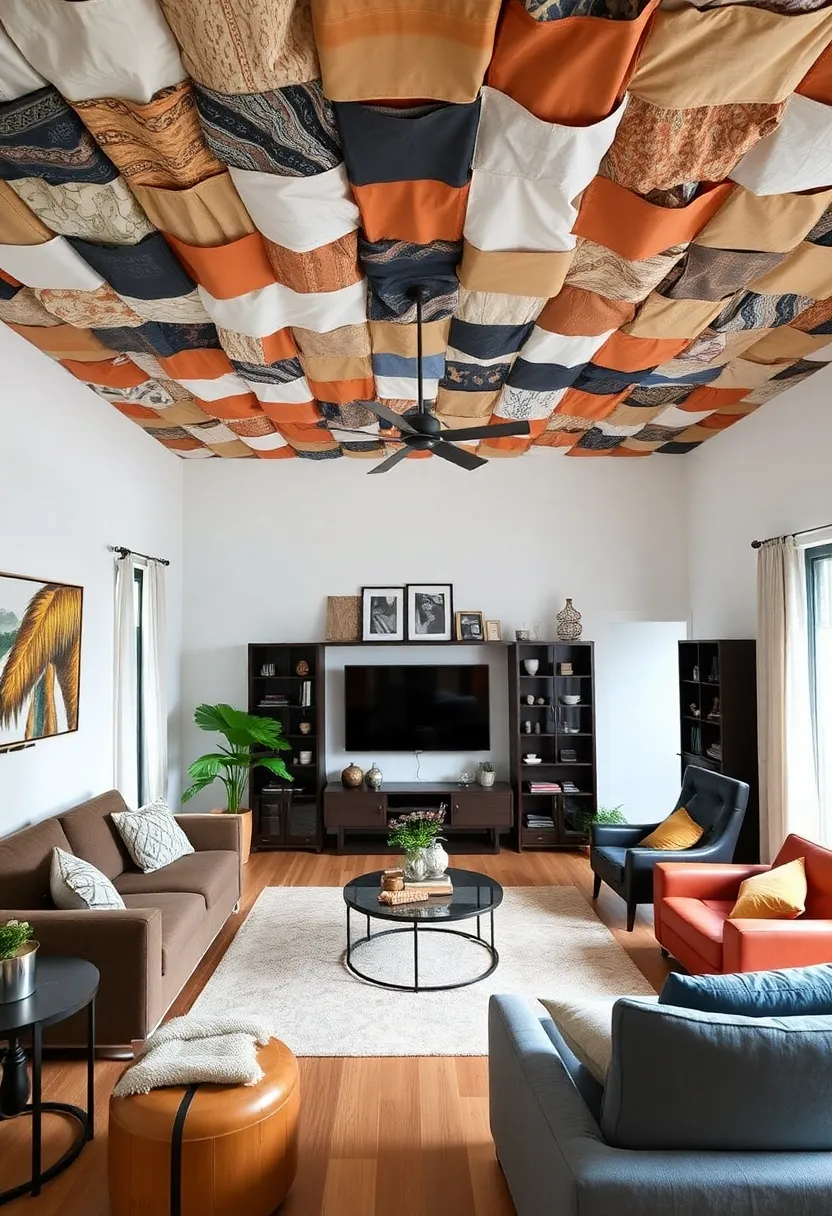
Using recycled materials for your ceiling is an excellent way to embrace sustainability and creativity. You can find a variety of options, from reclaimed wood to repurposed metal, each offering a unique look. This design approach allows you to harmonize with your living room decor while supporting eco-friendly practices. It’s a perfect way to express your style while being mindful of the environment.
Look for local sources of recycled materials to reduce your carbon footprint. Combining different materials can create a mixed-media effect that adds interest to your ceiling. Ensure that all materials are treated properly for durability, making your design both beautiful and lasting.
• Source materials locally to reduce your carbon footprint.
• Combine various materials for a mixed-media effect.
• Treat materials properly for durability.
• Embrace creativity while staying eco-friendly.
Recycled materials will elevate your living room’s style while supporting sustainable living.
Recycled Materials
Editor’s Choice

Inter-Wood 3D Reclaimed Barnwood Wall Planks – Vintage Barnwood Planks, …
 Amazon$149.99
Amazon$149.99![30+ Inspiring Living Room Ceiling Ideas for Every Design Style 105 American Tin Ceilings [5 Pack Kit] 24](https://m.media-amazon.com/images/I/71u5SM482JL._AC_UL320_.jpg)
American Tin Ceilings [5 Pack Kit] 24″ x 24″ 100% Tin Nail-Up Ceiling Ti…
 Amazon$50.00
Amazon$50.00
Tried & True Original Wood Finish, 8 oz. – Linseed Oil & Beeswax Blend, …
 Amazon$24.99
Amazon$24.9926. Coved Ceilings

Coved ceilings offer a smooth, elegant transition between walls and ceilings. This design feature adds a touch of sophistication while enhancing the perceived height of your living room. You can use eco-friendly materials for the cove design to stay true to sustainable practices. This style creates a graceful look, perfect for those looking to elevate their space.
Combine coved ceilings with recessed lighting for a soft, inviting glow. Painting the coves in a contrasting color can add dramatic flair, making your ceiling a stunning focal point. This design choice is ideal for creating a refined atmosphere in your living room.
• Use eco-friendly materials for sustainability.
• Combine with recessed lighting for a soft glow.
• Paint in a contrasting color for drama.
• Ensure furniture placement enhances the focal point.
Coved ceilings will add elegance and sophistication to your living room.
Coved Ceilings
Editor’s Choice

Zinnser 03688 Covers Up Stain Sealing Ceiling Paint, White
 Amazon$9.76
Amazon$9.76
Feit Electric LED Downlight Retrofit Kit with Baffle Trim, 75W Equivalen…
 Amazon$39.97
Amazon$39.97
Pangda Peel and Stick Wall Molding Kit, 3D Premade Accent Molding Wainsc…
 Amazon$119.99
Amazon$119.9927. Stenciled Ceilings

Stenciling your ceiling can introduce a playful and artistic touch to your living room. This approach allows for personalization, making your space truly unique. Using eco-friendly paints can keep your project sustainable while beautifying your ceiling. This method encourages creativity, perfect for those wanting to express their individual style.
Choose stencils that reflect your personality or theme to make a statement. Using complementary colors will help the design harmonize with your decor. Keeping the rest of your decor simple allows the ceiling to stand out beautifully.
• Choose stencils that reflect your personality.
• Use complementary colors for harmony.
• Keep the rest of the decor simple to let the ceiling shine.
• Utilize eco-friendly paints for sustainability.
Stenciled ceilings will add a fun and creative element to your living room.
Stenciled Ceilings
Editor’s Choice

Zonon 4 Pieces Reusable Tile Stencil Floor 12 x 12 Inches Wall Templates…
 Amazon$7.99
Amazon$7.99
Crayola Washable Paint (12ct), Bulk Paint Set for Kids’ Art Projects, 16…
 Amazon$45.91
Amazon$45.91
10PCS Palette Knife, Stainless Steel Painting Knife Set, Flexible Spatul…
 Amazon$6.98
Amazon$6.9828. Multi-Level Ceilings
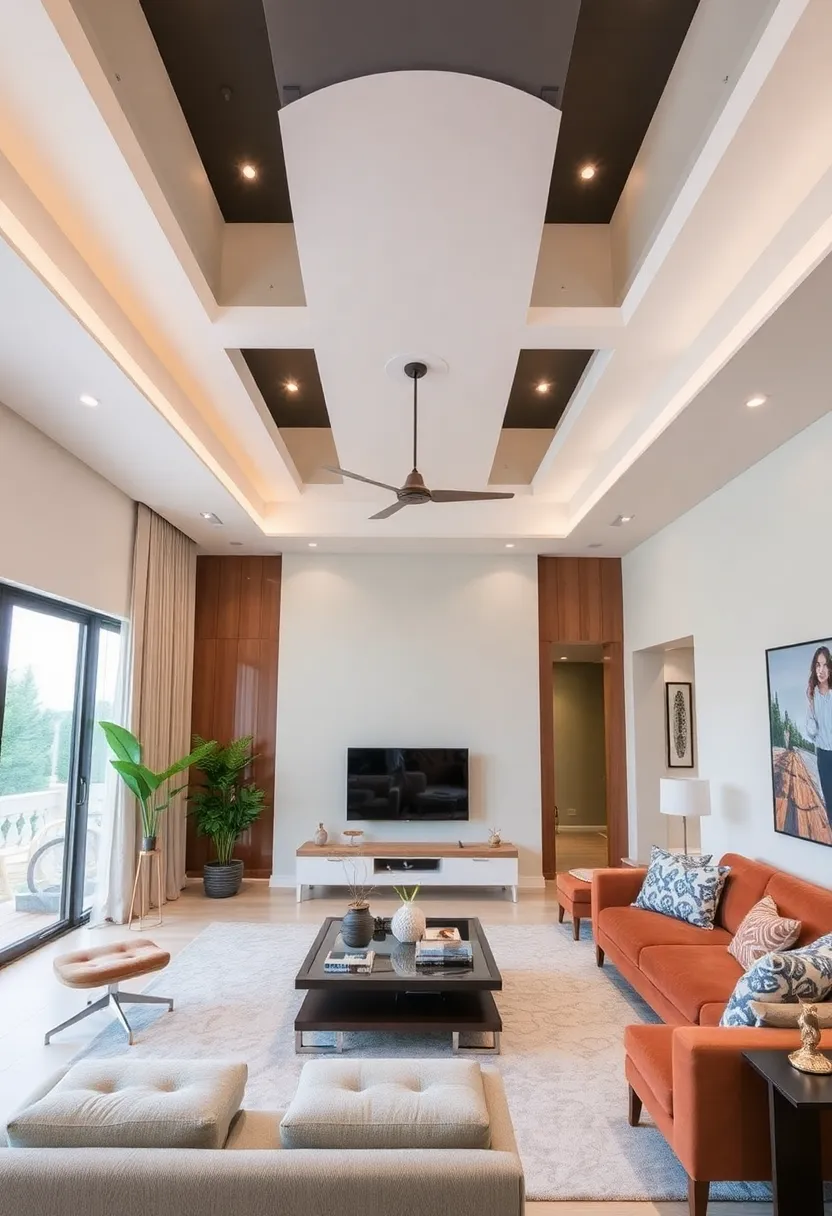
Multi-level ceilings can bring depth and dimension to your living room, making it feel more dynamic. This modern design element can be achieved using materials like wood and drywall, supporting sustainable choices. Carefully consider the layout to enhance the space’s functionality and flow. This approach creates visual interest while emphasizing sustainability.
Using different levels can help define separate areas within your living room, making it feel organized. Incorporating lighting in recessed sections adds flair and warmth to the design. This style is perfect for anyone looking to create a unique and engaging living space.
• Use different levels to define areas within the room.
• Incorporate lighting in recessed sections for flair.
• Choose materials that promote sustainability.
• Balance with low furniture for openness.
Multi-level ceilings will create a visually interesting and functional living room.
Multi-Level Ceilings
Editor’s Choice

Feit Electric LED Downlight Retrofit Kit with Baffle Trim, 75W Equivalen…
 Amazon$39.97
Amazon$39.97
Art3d Slat Wood Wall Paneling for Interior and Ceiling Decoration – Pack…
 Amazon$129.99
Amazon$129.99
Christopher Knight Home Carly Low Profile Accent Chair, Round Backrest S…
 Amazon$244.23
Amazon$244.2329. Custom Built-In Features
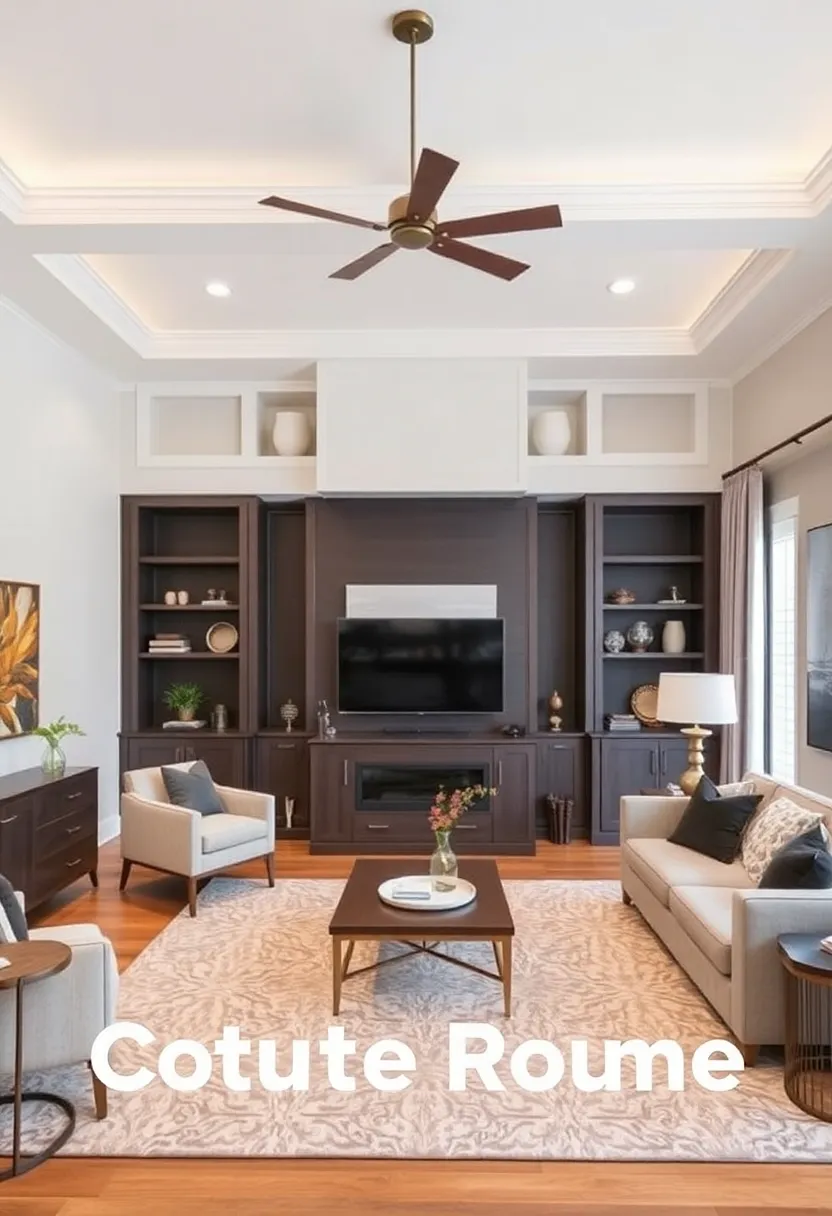
Incorporating custom built-in features into your ceiling design can elevate your living room’s functionality and style. These could be built-in shelving, lighting fixtures, or even hidden storage solutions. By using sustainable materials, you can align with eco-friendly living guidelines. This design choice merges creativity with practicality, making your space truly unique.
Use built-ins to display your favorite artwork or plants, adding personality to the room. Integrating LED lighting into these features provides a modern touch and enhances ambiance. Ensuring the design complements your overall aesthetic will create a cohesive look throughout your living room.
• Use built-ins for displaying artwork or plants.
• Integrate LED lighting for modern appeal.
• Ensure design complements overall aesthetic.
• Choose sustainable materials for eco-friendliness.
Custom built-in features will enhance your living space, making it both stylish and functional.
Custom Built-In Features
Editor’s Choice

DAYBETTER LED Strip Lights 130ft Lights Strip for Bedroom, Desk, Indoor …
 Amazon$9.99
Amazon$9.99
FOTOSOK 6-Tier Bamboo Shelf, Bamboo Bookcase with Adjustable Shelves, Fr…
 Amazon$63.99
Amazon$63.99
6 Pack 6 Inch Wall Plant Holder,Metal Plant Hanger Indoor,Wall Planters …
 Amazon$15.99
Amazon$15.9930. Nature-Inspired Ceiling Fans

Nature-inspired ceiling fans not only enhance airflow but also serve as a beautiful feature in your living room. You can select fans made from sustainable materials to align with your eco-conscious design. These functional decor pieces add personality while ensuring comfort in your space. Choosing the right fan can help create a cozy and inviting atmosphere.
When integrating ceiling fans, consider designs that complement your living room style for a seamless look. Ensure the size is proportionate to the room’s dimensions for optimal functionality. Look for energy-efficient models to minimize energy consumption, making your home both stylish and sustainable.
• Choose designs that complement your living room style.
• Ensure the size is appropriate for room dimensions.
• Opt for energy-efficient models to save energy.
• Select materials that are sustainable.
Nature-inspired ceiling fans will add a stylish touch while keeping your living room comfortable and eco-friendly.
Nature-Inspired Ceiling Fans
Editor’s Choice

Honeywell Ceiling Fans Willow View, 52 Inch Tropical Indoor Ceiling Fan …
 Amazon$149.99
Amazon$149.99
Amico Ceiling Fans with Lights, 42 inch Low Profile Ceiling Fan with Lig…
 Amazon$59.99
Amazon$59.99
Wood Ceiling Fan no Light, Walnut, 52″ Ceiling Fan Without Light, Flush …
 Amazon$158.99
Amazon$158.99Conclusion

The ceiling is a blank canvas waiting for your creative touch!
From rustic beams to eco-friendly materials and artistic elements, sustainable living room ceiling ideas can truly transform your space.
It’s all about finding the right harmony between style and sustainability to create a cozy and inviting atmosphere.
Which ceiling idea inspires you the most for your living room?
Note: We aim to provide accurate product links, but some may occasionally expire or become unavailable. If this happens, please search directly on Amazon for the product or a suitable alternative.
This post contains Amazon affiliate links, meaning we may earn a small commission if you purchase through our links, at no extra cost to you.
Frequently Asked Questions
What are some popular living room ceiling ideas for modern decor?
If you’re looking to elevate your living room decor, consider modern ceiling styles like coffered ceilings or tray ceilings. These designs create depth and character in a room, making it feel more spacious and stylish.
Another trendy option is using wood beams for a rustic touch, or opting for a sleek, minimalist approach with a flat white ceiling accented by bold lighting fixtures. Don’t forget to incorporate sustainable materials to align with eco-friendly living!
How can I make my living room ceiling more sustainable?
Going green with your living room ceiling can be both stylish and eco-friendly! Start by using sustainable materials like reclaimed wood or bamboo, which add warmth and texture while being environmentally conscious.
Consider energy-efficient lighting options, such as LED fixtures, that not only save energy but can also be creatively integrated into your ceiling design. Additionally, incorporating greenery or living walls can enhance air quality and bring a refreshing vibe to your living space.
What are some creative ceiling treatments that can transform my living room?
There are so many fun and creative ceiling treatments to explore! Think about adding textured wallpaper or using decorative tiles for a unique look. You could also paint your ceiling a bold color to create a striking contrast with the walls.
Another idea is to install hanging decor like pendant lights or artistic installations, which can turn your ceiling into a focal point of your living room. Just let your imagination run wild!
How do I choose the right ceiling design for my living room style?
Choosing the right ceiling design involves considering your overall living room style. For a modern aesthetic, sleek and minimal designs work best, while traditional styles might benefit from intricate moldings or coffered ceilings.
Take a moment to visualize how different ceiling styles can complement your furniture and decor. Don’t forget to consider factors like lighting and room dimensions to find a design that enhances your space beautifully!
Can I DIY my living room ceiling design, and what should I consider?
Absolutely! DIY-ing your living room ceiling can be a rewarding project. Start by assessing your skills and the complexity of the design you want to achieve. Simple ideas like painting or adding adhesive ceiling tiles are great for beginners.
Remember to plan carefully: measure your space, gather necessary materials, and always prioritize safety, especially when working at heights. This DIY endeavor can add a personal touch to your home while showcasing your creativity!
Related Topics
home decor
living room ceiling ideas
ceiling design ideas
modern ceiling styles
sustainable decor
creative ceiling treatments
interior inspiration
DIY ceiling projects
beginner friendly
trending designs
minimalist ceilings
cozy aesthetics

